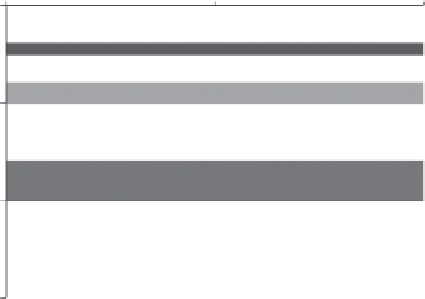Geoscience Reference
In-Depth Information
Concentration in liquid phase in soil (mg L
-1
)
1
0
0
0.5
R
= 4
R
= 2
-50
R
= 1
-100
Convection, no dispersion
Solute profiles after 50 days
-150
Figure 5.8
Effect of adsorption on the solute concentration proiles after 50 days. No
diffusion and dispersion are assumed. The experimental data of
Figure 5.2
apply.
Note the large difference in solute proile in case only convective luxes are consid-
ered (piston low) and in case dispersion and adsorption are included.
Equation (
5.17
) has the same mathematical form as Eq. (
5.9
), and therefore it has
the same solution as the one for Eq. (
5.9
), which is illustrated in
Figures 5.5
and 5.6.
The only difference is that for adsorbing chemicals the solute breakthrough time
T
res,R
equals:
L
v
RL
v
T
===
RT
(5.18)
res,R
res
R
Thus for steady-state conditions, an adsorbing solute would take
R
times as long to
reach a certain soil depth compared to a mobile solute.
Figure 5.10
provides an illustration of the breakthrough curve of our column
leaching experiment. Without adsorption the average residence time amounts to 50
d. In the case of adsorption this residence time increases in proportion to the retarda-
tion factor.
Figure 5.10
also shows that the solute dispersion increases in the case of
adsorption. Although the dispersion coeficient in Eq. (
5.17
) is reduced by a factor
R
, the travel time is increased, so that the amount of solute spreading as a function of
time observed at the outlow end actually appears to be greater than that of a mobile
chemical (Jury et al.,
1991
).
Question 5.9:
In the case of a vadose zone 10 m thick with volumetric water content
θ
= 0.15 and recharge
q
= 0.25 m y
-1
, the travel time of mobile nitrate amounts to 6 years.
For the same hydrologic conditions, calculate the residence time of an adsorbing pes-
ticide with a linear distribution coeficient and
S
d
= 2 cm
3
g
-1
. The soil has a dry bulk
density
ρ
b
= 1.5 g cm
-3
.


Search WWH ::

Custom Search